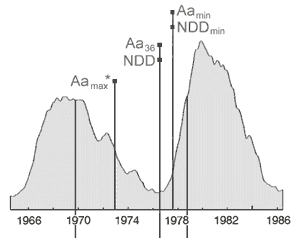
|

|

|
|
How to predict the solar cycle ? The methods to predict the solar cycle are medium-term methods and long-term methods. The medium-term methods predict the time profile of the cycle a few months in advance. They are in fact extrapolations of the last sunspot index RI12 observations, taking into account the time profiles of the past cycles. The predictions are generally restricted to about six months because the time profile is difficult to extrapolate, in particular at the beginning of the cycle. A method frequently used for operational purposes has been proposed by McNish and Lincoln. The prediction is based on the average solar cycle profile and is corrected according to the last RI12 observation.  Next figure (from Coffey, 1986) shows the mean cycle, the observed cycle (dots) and the prediction one year ahead (small open circles). The predictions presented here use this method. Another medium-term method uses artificial neural networks. Next figure (from Coffey, 1986) shows the mean cycle, the observed cycle (dots) and the prediction one year ahead (small open circles). The predictions presented here use this method. Another medium-term method uses artificial neural networks.The long-term prediction methods are mostly based on precursors. The precursors are related to measurements on the sun (polar faculae or coronal holes for example), to characteristics of the time profile of the cycle or to geomagnetic activity. We have selected 5 precursors of each of the last two classes. The precursor methods are simply obtained by application of a linear regression between the precursor (independent variable) and RImax (dependent variable). The statistics involved all the cycles for which the precursor is known. The efficiency of a method could be quantified with the regression coefficient r: a perfect methods would have r = 1 or r = -1. If the variables have no statistical relation at all the regression coefficient r = 0. A method is among the best if the regression coefficient is above 0.85 or below -0.85. All the methods based on geomagnetic indices and presented here have a regression coefficient r above 0.85. The figure illustrates the time at which each of the precursors are available. Precursors based on geomagnetic indices are at the top of the figure. Those based on the time profile of RI12 are below the curves. They are illustrated with pop-up windows. The precursors related to geomagnetic activity are the following :
You can find a more complete description of precursors and methods in the following articles (available in PDF through the "publications" section of this website) :
| ||
